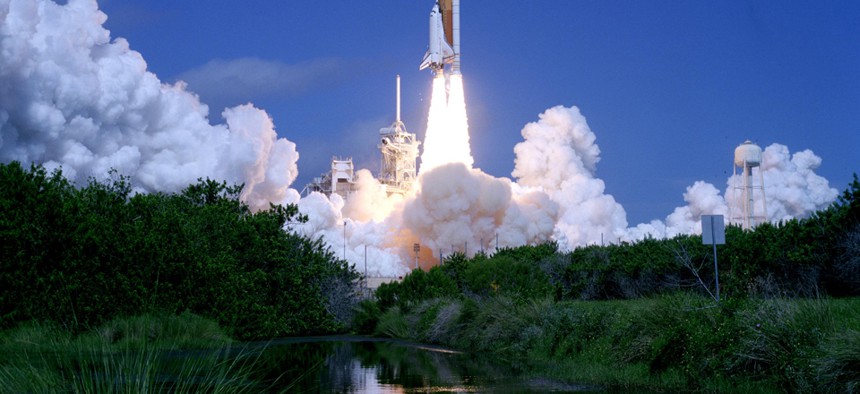Will Florida Get Pushed Out of the New Space Age?

Atlantis launched from Florida's Cape Canaveral in 2006. NASA file photo

Connecting state and local government leaders
To keep up with SpaceX and others, the historic Space Coast must adapt to commercial needs.
In the early 1960s, the Florida Development Commission released a short film promoting Cape Canaveral and Project Mercury, the glorious human spaceflight program taking shape there. According to the well-assured narrator, the Cape—the “Moonport of the free world”—was “so well suited for its role in the space age, it is almost as though it has been destined through the centuries just for this moment in history.”
Today, that destiny has become something of an encumbrance. The Space Coast, as the region just east of Orlando is often called, is still home to the Canaveral Air Force Base, NASA’s Kennedy Space Center (KSC), and countless companies set up to service these federal entities. But gone are the days of the monolithic, government-funded space program pictured in that flickering film. These days, commercial space is king, and a NASA legacy has left Florida a little too rigid to serve the market.
Exhibit A: SpaceX, that wildly ambitious space transport company often likened to Stark Industries, announced on Monday its plans to build the world’s first orbital launch pad dedicated to commercial business. It’ll be in Brownsville, Texas—not on the Space Coast.
“Obviously, we’re disappointed,” says Dale Ketcham, Chief of Strategic Alliances at Space Florida, a state aerospace economic development agency. “But we’re not really surprised. We understand what SpaceX desires in their efforts to compete on the global marketplace, and what we have to offer here right now involves NASA and the Air Force.”
These days, the commercial space industry—firms like SpaceX that sell launch services to satellite companies like AT&T, Sirius, and Dish—accounts for more than three-quarters of the global space economy . The rest is made up by government entities, including NASA, whose output has suffered tremendously due to deep funding cuts and the end of the manned shuttle program in 2011. Those shuttles—every manned spaceflight since 1968—were launched at the KSC. Its finale severed more than 18,000 jobs along the Coast, many of which were held by highly trained engineers and technicians.
This is not to say Florida was left blindsided; the state had been bracing itself for that blow. “You have to give them credit,” says Micah Walter-Range, Director of Research and Analysis at the Space Foundation. ”They’ve had some success in attracting companies there since.”
Indeed, both NASA and the Air Force have taken some strides to adapt their locations and business style to new companies. And a number of those vacant, top-skill shuttle positions have been filled by aircraft manufacturers like Boeing, who took over part of the old KSC processing facility, and Embraer, who set up shop near a regional airport. Even SpaceX has been using Florida facilities, with launch pads at KSC and Canaveral. But these Space Coast-based companies are largely providing services to the U.S. government—and less to the AT&Ts and Siriuses of the world. And they’re losing out on those customers’ money.
That’s because the Space Coast’s government-operated launch pads just aren’t flexible settings for commercial business. “As a commercial customer, you want some assurances that that pad is going to be available in the future and the way the government’s budgets are structured. If I have a customer who wants to fly to space in three years and I sign them up, I need to know that I have a launch pad to do that,” Rob Meyerson, president of Blue Origin, the Jeff Bezos-funded commercial space transport startup, has said.
Ketcham also adds that commercial customers have felt encumbered at government facilities due to redundant safety requirements and heavy oversight over access. He agrees with Meyerson that commercial launches don’t always get prioritized. “It’s always going to be exploration and national security first,” he says. “Which is as it should be. But there’s a limit to just how commercially friendly the government facilities can be.”
This has been a challenge for not only Florida, but also the U.S. space economy at large: While once the U.S. performed virtually all of the 20 to 25 commercial launches that happen every year, it has lost its market share to Russia, Europe, and China. SpaceX has said that its new, FAA-monitored Brownsville pad will see 12 unmanned rocket launches per year, ferrying satellites and other cargo into orbit. That could bring the U.S. back up the charts in the commercial sector. But when will Florida step up to bat?
The answer might lie in Space Florida’s proposal for its own commercial launch pad, known as Shiloh. It would take up about 200 acres within the Merritt Island National Wildlife Refuge, just north of the KSC. Right now the plans are undergoing an environmental review, and not surprisingly, there’s been a great deal of pushback from environmental groups. Even NASA hasn’t been entirely supportive. “They want to be the home of commercial space,” says Ketcham. “And they are trying to make that happen. But they'll just never be as attractive as a non-NASA spaceport like Brownsville.”
But Shiloh is in the works, and other commercial launch companies, including Blue Origin, have expressed interest in occupying such a space. And, as Walter-Range points out, SpaceX has stressed their new facility will be designed to launch cargo only—no human spaceflights. “But that could change down the road,” he says. “They’ve could decide that makes sense to do that at KSC.” It’s speculation, but who knows? The historic Moonport, land of the astronauts, could rise again.




